Wild hogs, also known as feral swine, have been rooting up trouble for years, but the spread of their species through most of Alabama’s 67 counties has Auburn University (AU) Extension specialists concerned, the Alabama Farmers Federation said in a recent website posting.
Wild sows begin having piglets at six months and can produce upwards of 50 piglets from four litters yearly.
The pigs' rooting in search of food damages native plant communities that provide habitat and food sources for indigenous wildlife species. Feral swine also degrade water quality and create a threat of disease for both humans and livestock.
“Although we have a somewhat fair guess of the damage that wild pigs cause to agriculture – about $1.5 billion per year – I suspect their impact to natural ecosystems and the environment likely double or triple that figure,” Dr. Mark Smith, an extension specialist and an associate professor at AU, said.
Alabama landowners can apply for financial assistance through the state's Wild Pig Damage Management Program, which is supported by the Environmental Quality Incentive Program,
to monitor and manage feral swine on their property.
Under guidelines of the program, landowners with 200 or fewer acres will be eligible for a practice payment of $831 (one trapping “scenario”), and landowners with 400 or more acres will be eligible for a practice payment of $1,662.
Cooperation with at least three nearby landowners is required whereby each landowner agrees to sign up for the program and work together to remove feral swine on adjoining properties. Landowners must also agree to complete photo and pig harvest data sheets and an AU damage survey.
For more information, contact the U.S. Department of Agriculture’s Natural Resources Conservation Service or nearest Farm Service Agency office. The application period for funding closes Jan. 20.
Wild hogs a growing problem in Alabama




 Alerts Sign-up
Alerts Sign-up